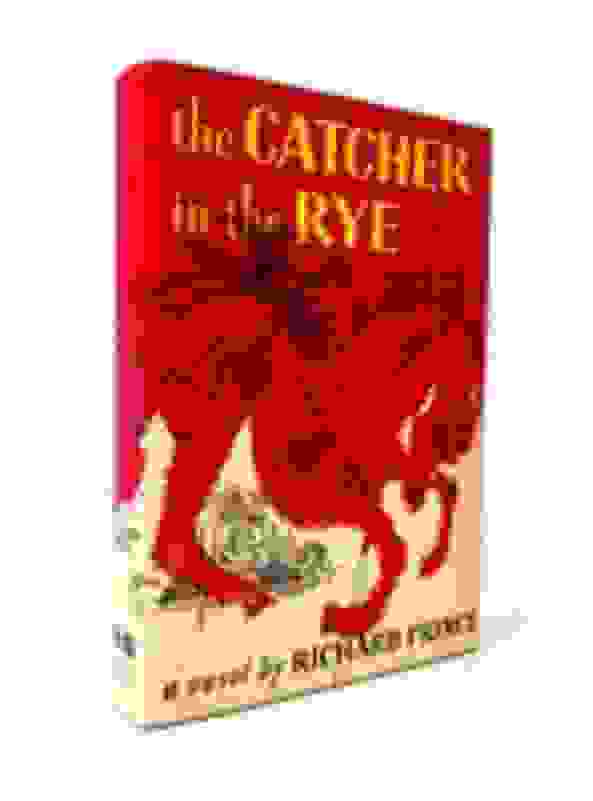Jan 1, 2024(Jan. 01, 2024) See all related content → cover of The Catcher in the Rye Reproduction of the cover of the first edition of J.D. Salinger’s novel The Catcher in the Rye (1951). The Catcher in the Rye, novel by J.D. Salinger published in 1951.
Strange Dark Stories: The Catcher In The Rye and Life Is Strange
The Catcher in the Rye is a novel by American author J. D. Salinger that was partially published in serial form 1945-46 before being novelized in 1951. Originally intended for adults, it is often read by adolescents for its themes of angst and alienation, and as a critique of superficiality in society. The novel also deals with themes of innocence, identity, belonging, loss, connection, sex

Source Image: artsy.net
Download Image
J.D. Salinger’s The Catcher in the Rye is a classic coming-of-age story. Narrated by sixteen-year-old Holden Caulfield, the novel paints a portrait of a struggling teenage boy as he attempts to hide his emotional pain behind cynicism and false worldliness.

Source Image: athwart.org
Download Image
Interesting use of idiom “Horsing Around” in JD Salinger’s The Catcher in the Rye. Could this be why JD was in the series and the origin of BJ’s sitcom name? Am I The Catcher in the Rye Symbol Analysis. What Holden most wants to be in life is someone who stands on the edge of a cliff in a rye field catching children before they fall. This image is symbolic of his desire to save both himself and other children from having to experience the various hardships and perils of the adult world.

Source Image: cnbc.com
Download Image
The Meaning Of The Catcher In The Rye
The Catcher in the Rye Symbol Analysis. What Holden most wants to be in life is someone who stands on the edge of a cliff in a rye field catching children before they fall. This image is symbolic of his desire to save both himself and other children from having to experience the various hardships and perils of the adult world. The Catcher in the Rye is the story of Holden attempting to connect with other people and failing to do so, which causes him to dread maturity and cling to his idealized view of childhood. Most of the book recounts Holden’s quest for connection, following him through dozens of encounters large and small, with cab drivers, nuns, tourists, pimps, former classmates, and many others.
Bill Gates on the literary classic he calls his favorite book
Quick answer: The title The Catcher in the Rye refers to how Holden Caulfield sees himself. He tells his sister, Phoebe, that he wants to be a catcher in the rye, saving children running Lessons in Literature: The Catcher in the Rye | Making Meaning with Melissa

Source Image: makingmeaningwithmelissa.com
Download Image
PPT – Catcher Name Symbolism PowerPoint Presentation, free download – ID:2144420 Quick answer: The title The Catcher in the Rye refers to how Holden Caulfield sees himself. He tells his sister, Phoebe, that he wants to be a catcher in the rye, saving children running

Source Image: slideserve.com
Download Image
Strange Dark Stories: The Catcher In The Rye and Life Is Strange Jan 1, 2024(Jan. 01, 2024) See all related content → cover of The Catcher in the Rye Reproduction of the cover of the first edition of J.D. Salinger’s novel The Catcher in the Rye (1951). The Catcher in the Rye, novel by J.D. Salinger published in 1951.

Source Image: strangedarkstories.com
Download Image
Interesting use of idiom “Horsing Around” in JD Salinger’s The Catcher in the Rye. Could this be why JD was in the series and the origin of BJ’s sitcom name? Am I J.D. Salinger’s The Catcher in the Rye is a classic coming-of-age story. Narrated by sixteen-year-old Holden Caulfield, the novel paints a portrait of a struggling teenage boy as he attempts to hide his emotional pain behind cynicism and false worldliness.

Source Image: reddit.com
Download Image
The Catcher in the Rye – Why Aspiring Authors Should Read It Definition and Examples of Literary Terms The Catcher in The Rye Introduction of The Catcher in the Rye Jerome David Salinger ‘s The Catcher in the Rye was published as a serial from 1945 to 1946 and instantly caught the attention of teenagers and adults alike.

Source Image: carolyneregan.com
Download Image
Analyze the use of symbolism in J.D. Salinger ‘s The Catcher in the Rye – My Exam Solution The Catcher in the Rye Symbol Analysis. What Holden most wants to be in life is someone who stands on the edge of a cliff in a rye field catching children before they fall. This image is symbolic of his desire to save both himself and other children from having to experience the various hardships and perils of the adult world.

Source Image: myexamsolution.com
Download Image
The Catcher in the Rye – Wikipedia The Catcher in the Rye is the story of Holden attempting to connect with other people and failing to do so, which causes him to dread maturity and cling to his idealized view of childhood. Most of the book recounts Holden’s quest for connection, following him through dozens of encounters large and small, with cab drivers, nuns, tourists, pimps, former classmates, and many others.

Source Image: en.wikipedia.org
Download Image
PPT – Catcher Name Symbolism PowerPoint Presentation, free download – ID:2144420
The Catcher in the Rye – Wikipedia The Catcher in the Rye is a novel by American author J. D. Salinger that was partially published in serial form 1945-46 before being novelized in 1951. Originally intended for adults, it is often read by adolescents for its themes of angst and alienation, and as a critique of superficiality in society. The novel also deals with themes of innocence, identity, belonging, loss, connection, sex
Interesting use of idiom “Horsing Around” in JD Salinger’s The Catcher in the Rye. Could this be why JD was in the series and the origin of BJ’s sitcom name? Am I Analyze the use of symbolism in J.D. Salinger ‘s The Catcher in the Rye – My Exam Solution Definition and Examples of Literary Terms The Catcher in The Rye Introduction of The Catcher in the Rye Jerome David Salinger ‘s The Catcher in the Rye was published as a serial from 1945 to 1946 and instantly caught the attention of teenagers and adults alike.